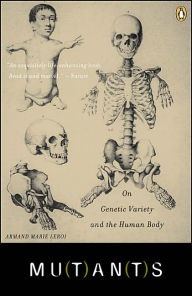Visit Armand Marie Leroi on the web: http://armandleroi.com/index.html
Stepping effortlessly from myth to cutting-edge science, Mutants gives a brilliant narrative account of our genetic code and the captivating people whose bodies have revealed it—a French convent girl who found herself changing sex at puberty; children who, echoing Homer’s Cyclops, are born with a single eye in the middle of their foreheads; a village of long-lived Croatian dwarves; one family, whose bodies were entirely covered with hair, was kept at the Burmese royal court for four generations and gave Darwin one of his keenest insights into heredity. This elegant, humane, and engaging book “captures what we know of the development of what makes us human” (Nature).
From the Publisher
"Combines meticulous historical research, [and] brand-new genetic understanding to tell an absorbing tale." —Matt Ridley, author of Genome"A marvelous accomplishment. A good look a the amazing prospect before us as we decode the human genome..." —The Seattle Times
Publishers Weekly
In a book that's as disturbing as it is enlightening, as unsettling as it is compelling, Leroi examines all sorts of genetic variability in humans and explains how that variability helps scientists understand the processes associated with human growth and development. Leroi, recipient of a Scientist for the New Century medal from the Royal Institution of Great Britain, demonstrates, in both text and pictures, that an enormous amount can go wrong as humans develop from fertilized eggs and progress toward old age. The missteps can result from genetic or environmental causes, with the latter occasionally responsible for the former. Although the subjects Leroi presents conjoined twins, individuals with cyclopia (a single eye), deformed or missing limbs, abnormal height, supernumerary breasts, an overabundance of body hair, piebald coloring often appear grotesque, he approaches all of his topics and each of his human subjects with great respect. Leroi uses each example to demonstrate the developmental lessons they illustrate: e.g., the role of fibroblast growth factors in the formation of limbs, the pituitary's impact on body size. By explaining that each of us carries hundreds of mutations within us, he asserts that we are not all that different from those who, on first glance, appear very disparate. Similarly, he effectively dismisses the belief that human races are anything more than a convenient social construct, establishing that there is no biological basis for such categorization. While the graphic pictures might deter some, they add immeasurably to the text. (Nov. 10) Copyright 2003 Reed Business Information.
Library Journal
British scientist Leroi (evolutionary developmental biology, Imperial Coll.) has compiled an assemblage of human deformities recorded throughout history. This story of human mutants describes many of the bizarre monstrosities that result when the "normal" genetic instructions are not, or cannot, be translated correctly. (In the past, these people were frequently labeled freaks and exhibited to the curious public.) Teratologies leading to extra limbs, or no limbs, and conjoined bodies known as Siamese twins are vividly described. Dwarfs and giants are contrasted, the tragic errors of faulty sex development are elucidated, and hairiness in "dog-faced" people and other aspects of anomalous development are illustrated. While this is a highly readable narrative of bizarre developmental outcomes, Leroi admits that the mutations that cause these events are not understood or in too many cases even identified. It must be emphasized that we all possess mutations, but fortunately these mutations are not, for the most part, notably deleterious. Natalie Angier's Woman covers several of these conditions with greater clarity. Writing for the general reader, Leroi keeps technical aspects of the science to a minimum. Suitable for all public libraries where there is an interest in the history of science and medicine.-Rita Hoots, Woodland Coll., CA Copyright 2003 Reed Business Information.
Read More
















